What Do the Colors of the German Flag Mean
European soccer championship enthusiasts like to wear their national colors. Germany's fans sport black, red and gold. The colors have a checkered history.
Following a long reflection process, the authors of Germany's new constitution, the Basic Law, added the following sentence into Article 22 in 1949: "The federal flag is black-red-gold."
In fact, the color combination already had at least 200 years of history behind it in Germany.
Nowadays, the flag represents a tradition of freedom and democracy, but it was a long and winding road to get there.
The roots of the black-red-gold triad were long thought to have been in the Middle Ages. Although the coat of arms of the Holy Roman Empire of the German Nation showed a black eagle with red legs against a gold background, those were not the official colors of the empire.
The alleged origins in the Middle Ages
The color combination only became a political symbol in the aftermath of the War of the Sixth Coalition (also known as the "Wars of Liberation") beginning in 1813 against the French Empire under Napoleon Bonaparte, who had occupied large parts of Germany.

Revolution 1848: Here, barricade fights on March 18 and 19 in Berlin. The orientation of the black-red-gold colors on the flags still varied
During the war, Prussian propaganda highlighted one fighting unit in particular: the volunteer corps of Major Ludwig Adolf Wilhelm von Lützow, which then became known as the "Lützower Jäger" (Lützow hunters).
The corps owed its fame not least to notable members such as Friedrich Ludwig Jahn, who was nicknamed "Turnvater" (father of gymnastics) because of his sports achievements, the Romantic Age composer Carl Maria von Weber and the writer Theodor Körner, who dedicated his popular poem Lützow's Wild Hunt to the regiment.
Anti-French sentiment
While Jahn remains controversial for antisemitic statements, Körner's war poem is steeped in patriotic fervor, reflecting the anti-French spirit of his era:
Frisch auf, mein Volk!
Die Flammenzeichen rauchen,
Hell aus dem Norden bricht der Freiheit Licht.
Du sollst den Stahl in Feindes Herzen tauchen,
Wasch' die Erde,
Dein deutsches Land mit deinem Blute rein!
Wake up, my people!
The smoke signals are there,
Bright from the North shines the light of freedom.
You shall plunge steel into the enemy's heart,
Wash the earth,
Your German land with your blood pure!
The Lützow Free Corps also made a name for itself through its appearance: black uniforms, red insignia and gold buttons. The black was born out of necessity — the volunteers brought their own uniforms. To make them look as similar as possible, it was easiest to dye them black. Other colors were hard to come by at the time.
Mocking France's color triad
In 1815, at the end of the liberation wars, student fraternities from all over Germany gathered in Jena to form a nationally united "Urburschenschaft" (Original Brotherhood) — largely initiated by Turnvater Jahn. They chose a vertically striped red-black-red flag with a golden branch in the middle, based on the colors of the Lützow uniforms.
These colors were adopted by the forces forming in Germany in the early 19th century, which called for a republic and national unity.
At the Hambach Festival in 1832, a huge festival of the democracy movement, yellow, red and black striped flags were waved. The French tricolor flag was then countered by a German tricolor one.
The colors symbolized national unity and civic freedom.
In 1848, in Frankfurt, the Bundestag (parliament), like the German National Assembly, declared black-red-gold to be the colors of the German Confederation or the German Reich that was to be founded. Thus, black-red-gold flags flew on some of Berlin's barricades during the revolution of 1848/49, just as they did at the German National Assembly in Frankfurt's St. Paul's Church.
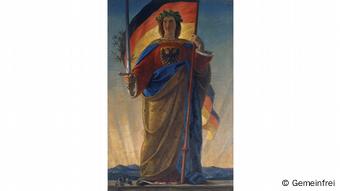
'Germania' enthroned above the National Assembly in St. Paul's church in Frankfurt, 1848
But after the bloody suppression of the revolution, only the Prussian-dominated German Confederation remained, which no longer wanted anything to do with the democratic black-red-gold. In fact, the color combination was even banned in some German states.
1871: Red-white-red vs. black-red-gold
On January 18, 1871, Otto von Bismarck read the Imperial Proclamation in the Hall of Mirrors at the Palace of Versailles. The victory over France in the Franco-Prussian War (1870/1871) led to the founding of the German Empire.
The colors of Prussia, white and black, supplemented by the red of the Hanseatic cities, became the colors of the national flag.
-
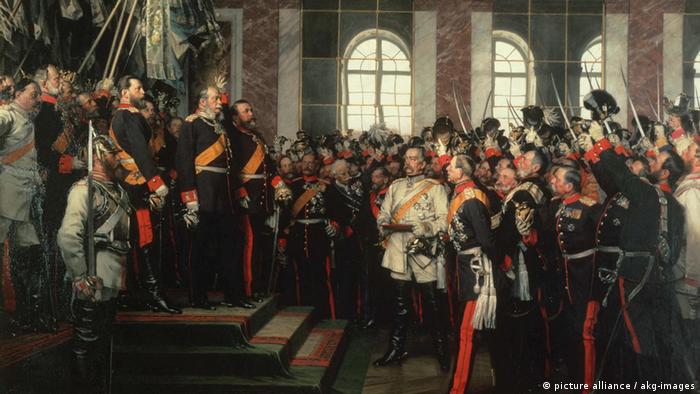
The Proclamation of the German Empire, 150 years ago
The Kaiser's proclamation
On January 18, 1871, Otto von Bismarck read out the proclamation of the Emperor of Prussia in the Hall of Mirrors at the Palace of Versailles. The German Reich was founded after Germany won the 1870-1871 war against France. The painter Anton von Werner was an eyewitness to the event and documented it in this painting made in 1885. Wilhelm I is standing on a stage surrounded by princes.
-
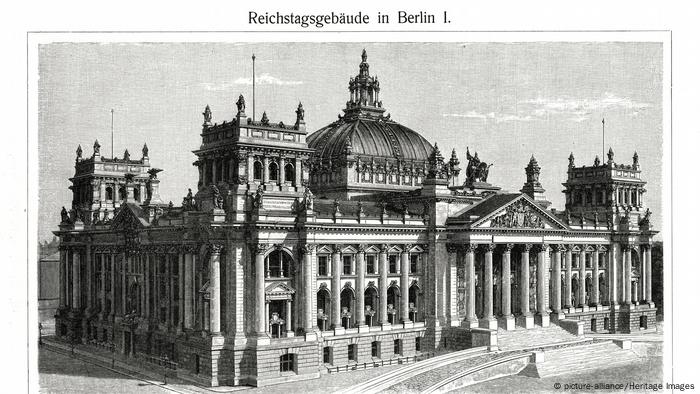
The Proclamation of the German Empire, 150 years ago
The Reichstag in Berlin
Berlin was the first capital of the German Reich. The Reichstag's foundation stone was laid on June 9, 1884, in a ceremony led by Emperor Wilhelm I and Otto von Bismarck, the first chancellor of the Reich. However, the Reichstag's construction took 10 years, and Wilhelm II put the final stone in the new building. Parliament was called to session a day after.
-
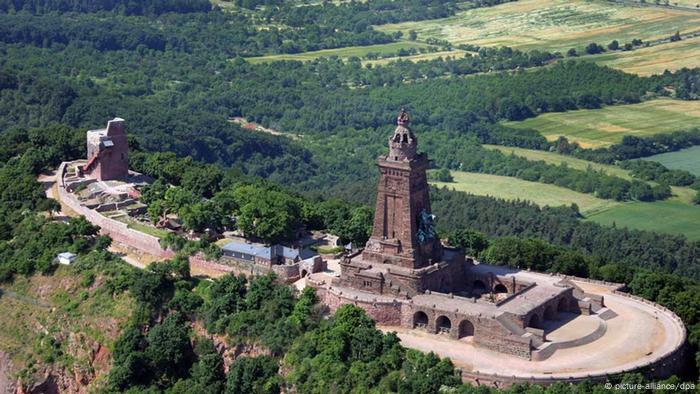
The Proclamation of the German Empire, 150 years ago
The Kyffhausen Castle
This monument with a statue of Emperor Wilhelm I on horseback and Emperor Friedrick I (1112-1190) was built upon the remains of the Kyffhausen Castle from around the 11th century. Today, the castle is one of the main tourist attractions in Thuringia.
-
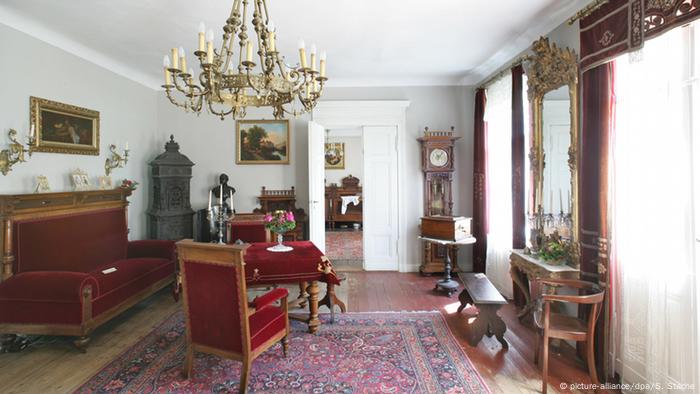
The Proclamation of the German Empire, 150 years ago
Living as the Wilhelminians did
The Gründerzeit ("Founder Epoch") Museum in Berlin takes the visitor back to the era between 1871 and 1914. The valuable furnishings of the time aimed to reflect prestige. With angular forms, elaborate decorations, curved legs with ball-like bases, chairs, grandfather clocks and mirrors often had crown-like decorations.
-
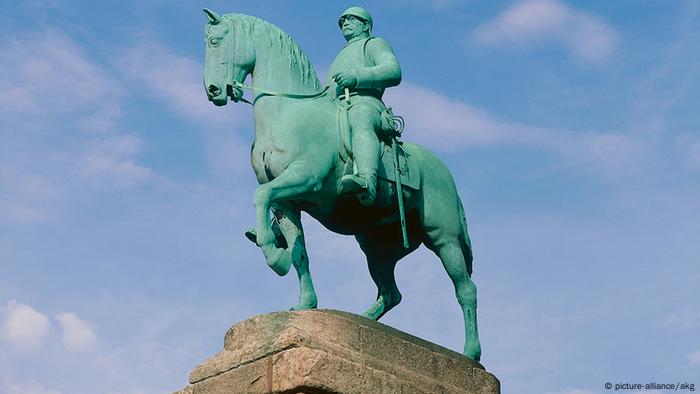
The Proclamation of the German Empire, 150 years ago
A Bismarck made of stone
Globally, there are around 10,000 places with a reference to Otto von Bismarck. Bismarck monuments were made between 1868 and 1934 and include statues of the chancellor riding a horse or depicting him as a warrior. Former colonies of Germany also have some leftover monuments to the German statesman. There is a Bismarck square in Dar es-Salaam and Bismarck mountains in Papua New Guinea.
-
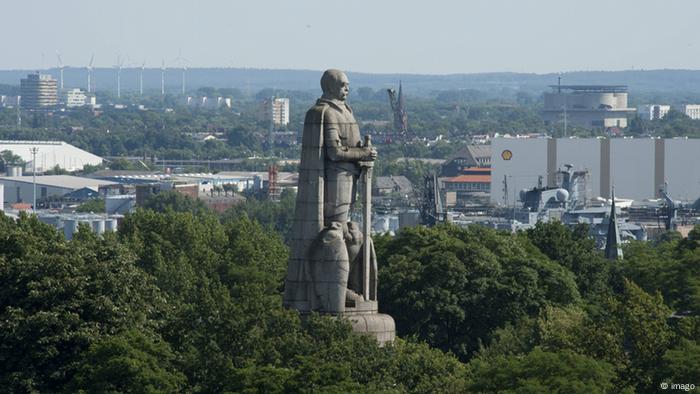
The Proclamation of the German Empire, 150 years ago
A towering chancellor
Otto von Bismarck was the founder of the German Reich in 1871. As the first chancellor, he was conservative but also modern. The Bismarck monument in the Old Elbe park in Hamburg was constructed in the years between 1901 to 1906, following plans by the architect Emil Schaudt and the sculptor Hugo Lederer.
-
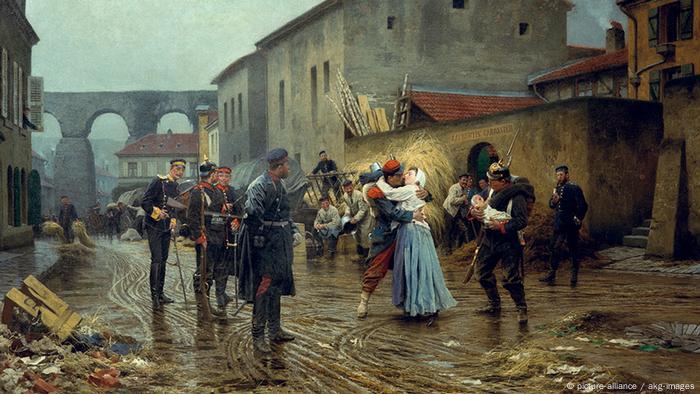
The Proclamation of the German Empire, 150 years ago
The Franco-Prussian war
Scenes from the Franco-Prussian war of 1870-1871, with Germany's victory over the French, was one of the favorite themes of painters in the Wilhelminian period. This painting is also by Anton von Werner. It shows a French soldier taking leave from his wife, while a German musketeer holds the baby.
-
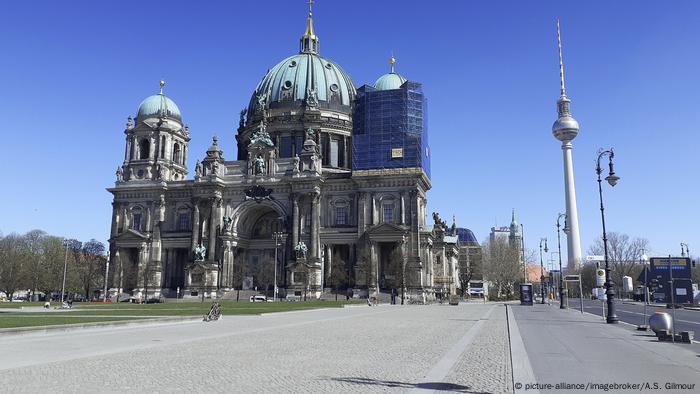
The Proclamation of the German Empire, 150 years ago
The Berlin Cathedral
The new German Reich also needed a representative church. As the King of Prussia, Wilhelm II ordered the demolition of the Schinkel Cathedral and the construction of a new cathedral according to the plans of the architect Julius Raschdorf. Its form is reminiscent of Italian renaissance and Baroque styles. The cathedral was inaugurated on February 27, 1905.
-

The Proclamation of the German Empire, 150 years ago
The Bode museum
In memory of his father, Wilhelm II ordered the construction of the Kaiser Friedrich Museum, now known as the Bode Museum, in Berlin. With its stucco-decorated domed hall and the twin stairways, it became known as the "museum palace." It served as a hall of fame for the Hohenzollern dynasty and for renaissance art. It was renovated and reopened in 2006.
-
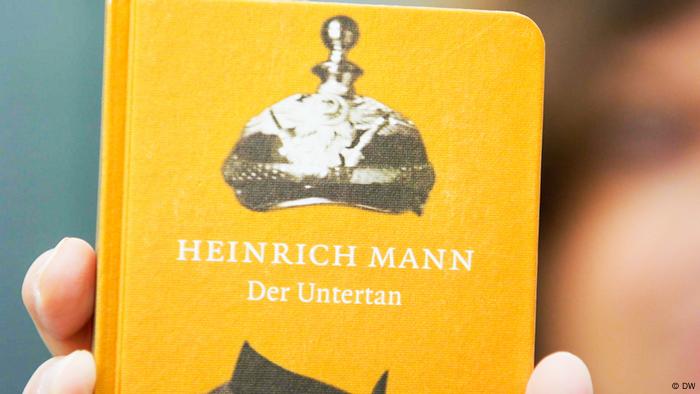
The Proclamation of the German Empire, 150 years ago
Heinrich Mann's "Der Untertan"
In his novel "Der Untertan" (translated into English under the titles "Man of Straw," "The Patrioteer," and "The Loyal Subject"), Heinrich Mann analyzed power relations in the Reich under Wilhelm II. Mann wrote the novel between 1906 and 1914. It was released as a book in 1918. The story is about the moral cowardice and opportunism of Diederich Hessling, who elbows his way up the social ladder.
In 1919, the National Assembly, which met in Weimar after the collapse of the German Empire, again designated black-red-gold as the flag of the newly founded Weimar Republic.
This was preceded by a bitter "flag dispute" between republicans, who demanded black-red-gold, and monarchists and communists, who wanted an all-red flag.
1935: Swastika replaces black-red-gold
The black-red-gold flag remained the state flag until September 1935. At a Nuremberg Nazi Party Rally, not only were the "race laws" passed, but the Nazi swastika flag was also declared the national flag. At the same time, Jews were forbidden to hoist it.
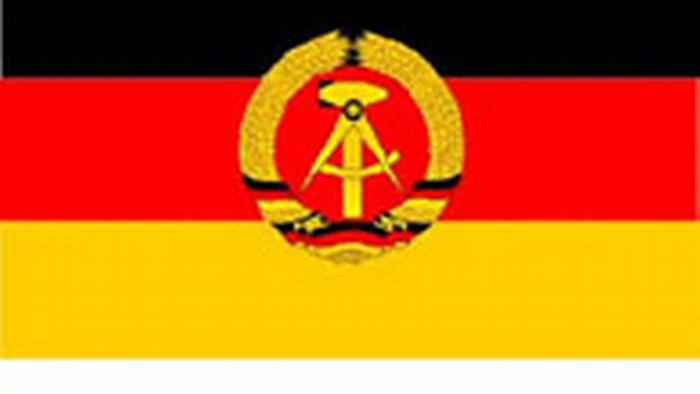
The GDR version of the black-red-gold flag was introduced in 1959
The excessive use and abuse of national symbols in Nazi Germany led to a more restrained approach after the end of the Second World War and the early days of the Federal Republic of Germany, established in 1949.
That same year, the Parliamentary Council decided, with one dissenting vote, in favor of black-red-gold as the colors of the state flag of the Federal Republic of Germany.
But even the young state could not do without symbols, and in 1950 it added a national coat of arms to the black, red and gold flag: a stylized black eagle against a gold background with red claws looking to the right. A late descendant of the eagle that had fluttered on the coat of arms of the Holy Roman Empire of the German Nation.
Black-red-gold again
This "federal service flag is reserved for official agencies of the federal government," the Federal Ministry of the Interior clarified at the time.
Anyone waving the flag at a national team match, for example, was formally committing a public offense that could be punished with a fine.
There was also continued wrangling over the use of the "federal eagle" on the jerseys of the German national soccer and handball teams.
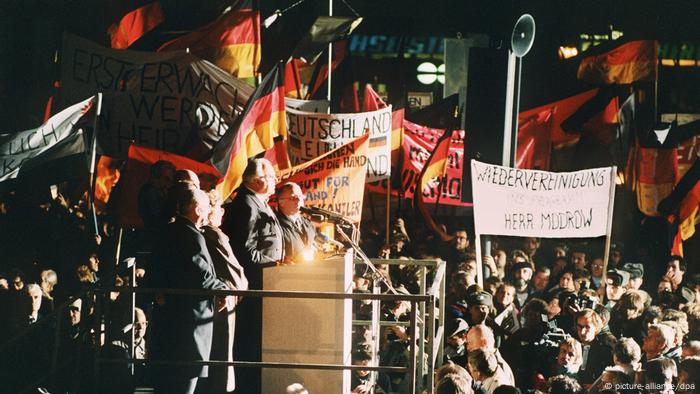
East German demonstrators greet then-Chancellor Helmut Kohl with West German flags in Dresden in 1989
Black-red-gold federal flags made a grand entrance during the so-called peaceful revolution in East Germany in 1989 with protesters against the SED regime waving black-red-gold flags — but without the state symbols of the GDR.
The GDR had also declared black, red and gold to be the state flag, later adding onto it the emblem of a stylized hammer and a compass in the middle of a wreath of ears of corn.
Today the black-red-gold color-triad stands for a Germany open to the world. But right-wing extremist and racist demonstrators also misuse the black-red-gold flags for their own purposes.
This article was adapted from German.
What Do the Colors of the German Flag Mean
Source: https://www.dw.com/en/black-red-gold-the-origins-of-the-german-flag/a-57905053